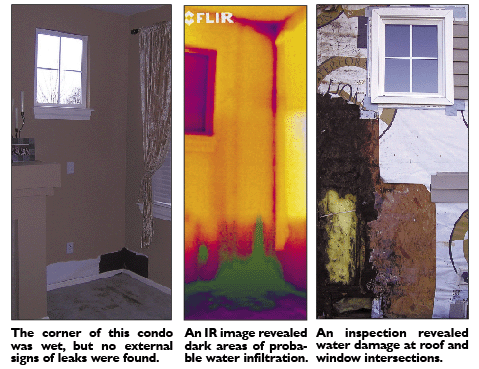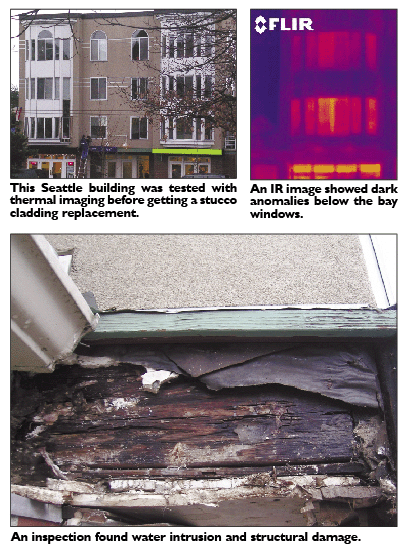
Surveys
Awards
DJC.COM
March 23, 2006
See through walls to find water leaks
Corke Amento
There's a new tool in building diagnostics and it is called infrared thermography. If a picture says a thousand words, thermography says 10,000. It is the only diagnostic technology that allows the user to instantly visualize and verify thermal performance.
Thermography is the use of an infrared imaging camera to "see" and "measure" thermal energy emitted from an object. Thermal, or infrared energy, is light that is not visible because its wavelength is too long to be detected by the human eye; it's the part of the electromagnetic spectrum that we perceive as heat. The higher the object's temperature, the greater the IR radiation emitted. As it turns out, water has a great capacity to store (emit) heat.
Water, air flow and heat are key hygrothermal factors in a building's performance. Leaking walls or windows, missing insulation, and uncontrolled air drafts carrying warm moist interior air will quickly damage building components if left unchecked. Fortunately, these factors can be seen and measured using a thermal camera, then documented in seconds as an ordinary digital photo. The problem areas can be followed up with selective invasive testing to verify underlying conditions.
Water leakage is the number one factor that leads to damaged finishes, membranes, framing components, structural collapse and the growth of mold. Infrared cameras can be used to quickly locate the ultimate source with little or no physical disassembly of the premises and minimal disturbance of inhabitants. Determining the source of water intrusion and getting it fixed right the first time is the goal.
Actual investigations demonstrate the effectiveness and accuracy of this new and improved thermal imaging technology. In most instances, normal inspection techniques will not identify these issues as thoroughly and effectively. Infrared inspection enables a powerful noninvasive method to monitor and diagnose the condition of buildings and quickly identify problem areas that can't be seen by the naked eye.
This technology is applicable to anyone involved with buildings such as property managers, building owners, contractors and maintenance supervisors. It can be used on both interior and exterior and at any time during the building's life cycle.
Even though this technology is expensive and photo interpretation should only be done by certified professionals, it is considerably more cost-effective than the old version of "hunt and peck" invasive investigation techniques.
Thermography used on local buildings
Renton condo
A resident moved her corner bookcase to finish painting the interior of her unit and reported the carpet was wet underneath her bookcase. Visual inspection of the exterior and interior of the unit revealed no water stains or cracking typically accompanying an exterior water leak, other than wet carpet.
Typical pin-type moisture meter readings revealed no significant levels of moisture in the wall. However, thermal imaging revealed anomalies consistent with leaks at the roof flashing and a window corner. This prompted an exterior invasive inspection that discovered both the roof and window were allowing water into the corner of the building.
Extensive exterior water damage, structural decay, and microbial growth required several thousand dollars worth of repairs to rectify. Without the thermal imaging, typical inspection techniques most likely would not have fully diagnosed the problem or true extent of damage.

|
Seattle mixed-use building
This building was undergoing a phased replacement of 20-year-old stucco cladding. The objective was to determine repair allowances for the reconstruction estimate and scope of repair.
The owner had a limited budget for invasive testing to determine the extent of necessary allowances so it was decided to quickly scan the exterior of the building and focus the inspection on any anomalies discovered.
The thermal imaging revealed anomalies consistent with water intrusion at the bay windows and several other suspected areas where the sealants had failed and construction techniques were questionable. Invasive testing at the base of the bay windows revealed extensive water intrusion and structural decay.
This tool helped the owner set budget guidelines for the upcoming repair, and minimized the investigation disruption to the first floor commercial tenants.

|
Jens C. Johanson is a principal and Certified Building Science Thermographer at Corke Amento, a construction consultant employing two of the few certified inspectors on the West Coast.
Other Stories:
- A bright outlook for local construction
- Scoccolo case could hurt contractors, taxpayers
- How much do you know about forklift safety?
- Are you communicating clearly? Your bottom line is at stake
- Sound Transit digs a cutting-edge tunnel
- Need a tower crane? Take a number
- It only takes a minute — to get hurt
- Get a handle on escalating costs
- Joint ventures are like marriages — know your partner
- Engineered lumber makers step it up
Copyright ©2009 Seattle Daily Journal and DJC.COM.
Comments? Questions? Contact us.